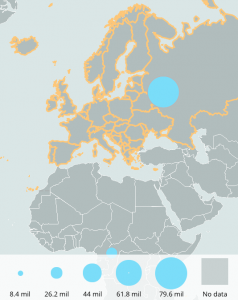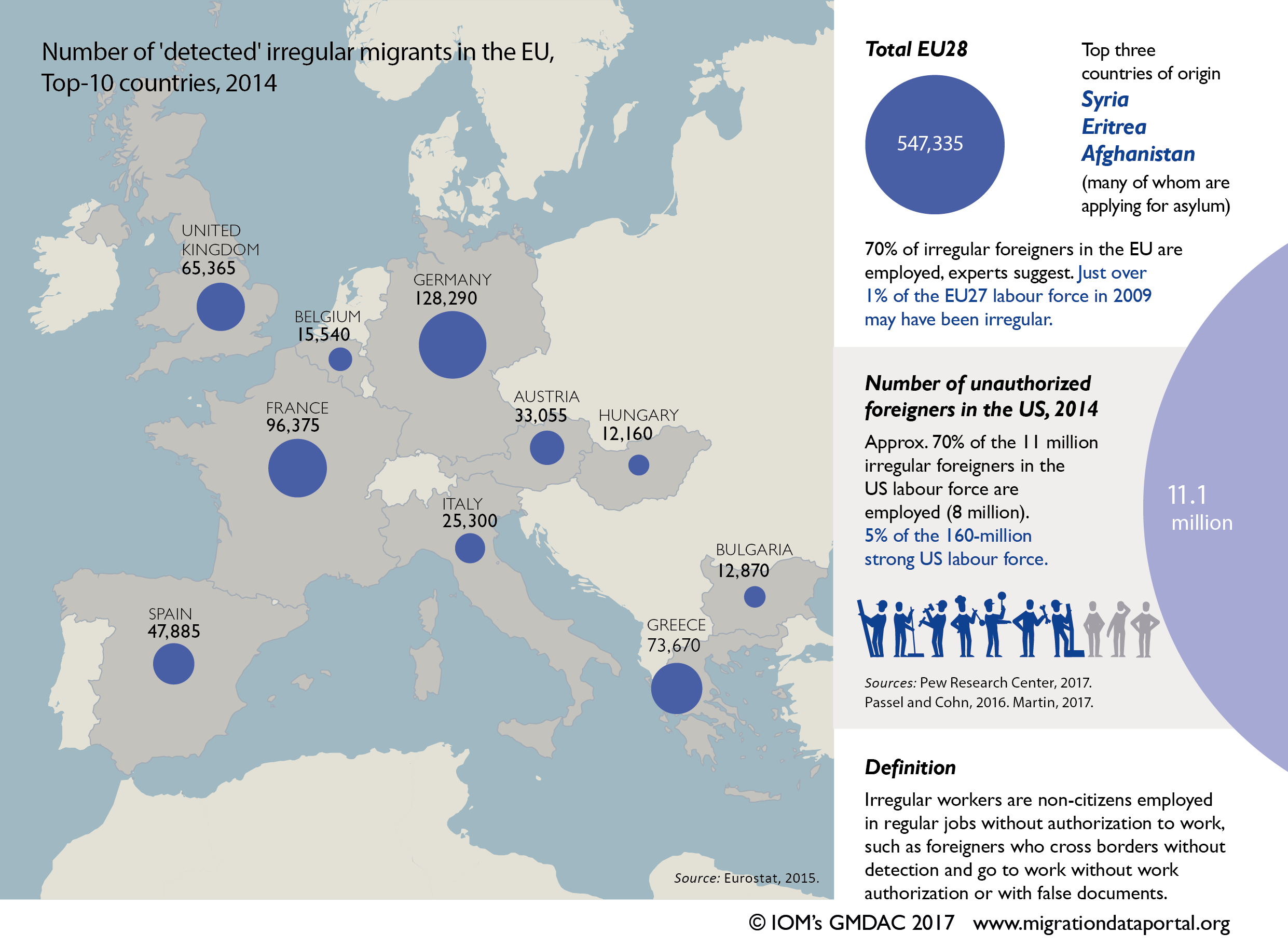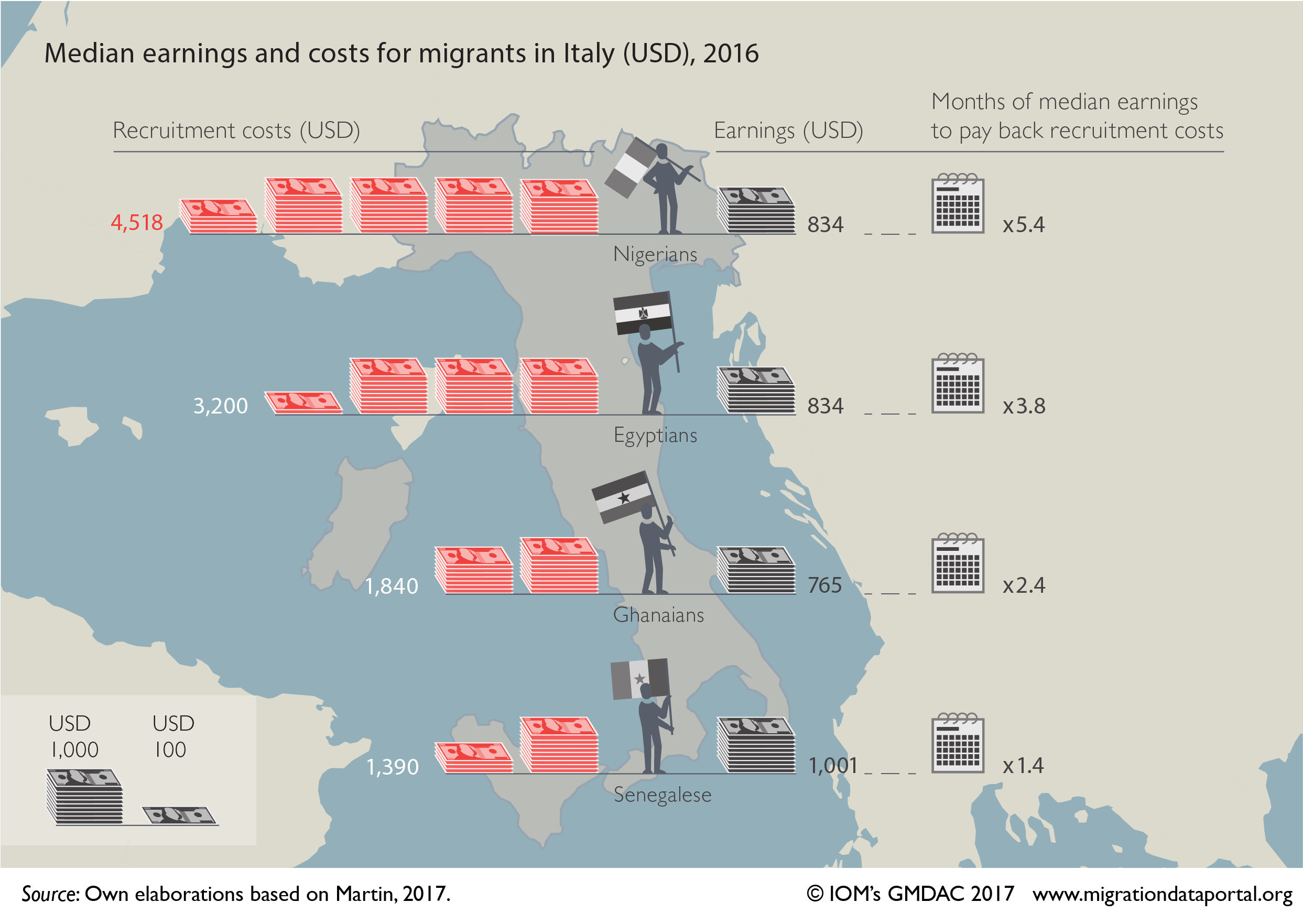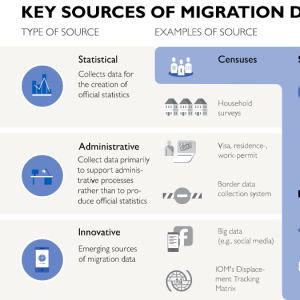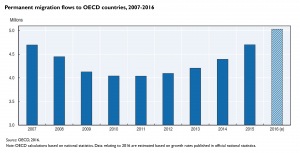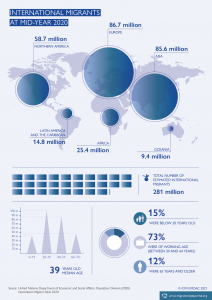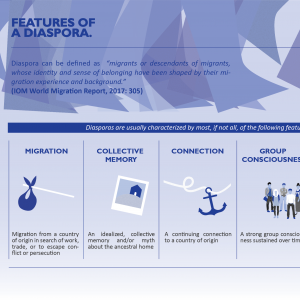
Migration data in Europe
A wide range of migration data is collected and disseminated in Europe at national and, sometimes, subnational level. Institutional and legal frameworks have been developed by the European Union (EU) with the aim of ensuring that migration data are of high quality, comparable across countries as a result of harmonization (as established in the legal basis) and easily accessible. A continuous process of political dialogue is in place to ensure that the frameworks keep pace with increased demands for information and knowledge.
Key trends
COVID-19
The COVID-19 pandemic has affected migration and human mobility in the European region as countries have restricted international, transborder and internal movements to minimize the spread and impact of the pandemic. As of mid-June 2020, 6 per cent of airports, 25 per cent of land border crossing points and 9 per cent of “blue border” (sea, river or lake) crossing points were closed for their entry and exits in the European Economic Area (EEA) (IOM, 2020).
The pandemic has substantially reduced the number of irregular arrivals to the EU in the past months. In April 2020, the number of detections of irregular border crossing (IBCs) on Europe’s main migratory routes fell by 85 per cent from the previous month to around 900, the lowest total since Frontex began collecting border data in 2009 (Frontex, 2020). The record low numbers were mainly due to the restrictive measures implemented both by the EU Member States and by third-countries of transit and departure of migration.
The number of asylum applications in the first quarter of 2020 has remained on the level of the same period in 2019 and has significantly decreased since then. In April 2020, there was a big huge drop in the overall number of applications for international protection lodged in the EU Member States, continuing the decline which began in March. The ongoing COVID-19 pandemic and the respective emergency measures introduced by the EU Member States, including the suspension of applications’ registration, had an impact on the inflow of applications.
The pandemic has also affected employment and migrants’ integration as closures and social distancing measures have made an impact on administrative procedures for obtaining residence and work permits, language acquisition, and integration programmes (EC, 2020). At the same time, European countries are implementing some good practices that support migrants across various integration areas (Council of Europe, 2020). Moreover, the pandemic has highlighted the role that migrant workers play in Europe's coronavirus response; according to study by the European Commission’s Joint Research Centre, 13 per cent of key workers are immigrants, and in most countries, the share of Extra-EU key workers is larger than the EU-mobile one (JRC, 2020).
For an overview of migration data relevant to COVID-19, including data covering European countries, go to the Portal’s new thematic page.
General trends
- Migration has become much more diverse in terms of origins of migrants.
- Both globally and in Europe, most migration is intra-continental.
- The number of refugees is on the rise worldwide. Most refugees seek harbour in neighbouring countries. Since 2015, with the so-called “refugees and migrant crisis”, Europe too has dealt with increasing numbers of asylum seekers. 2.4 million refugees and people in refugee-like situations and 860 thousand asylum-seekers (pending cases) were hosted in EU-27 Member States at the end of 2018.
- Over 160,000 migrants found to be irregularly present in the EU return annually to their countries of origin, whether from enforced or voluntary returns; many more return voluntarily when their circumstances change (e.g. end of studies, family reasons, employment).
-
A total of 28,256 migrants were assisted by IOM to return from the European Economic Area (EEA) in 2019, which accounted for 43.6 per cent of the total caseload. Germany was the top host country in the EEA with the highest number of beneficiaries assisted or 13, 053 migrants (IOM, 2020).
- The competition for talent has become global. In this context, Europe is working on a number of initiatives to attract more highly skilled migrants.
- In the Western Hemisphere and Europe in particular, the salience of migration as a political and social concern has intensified.
Sources: UNDESA International Migration Report 2019; UNHCR Global Report 2018; Standard Eurobarometer 90 Autumn 2019; Pew FactTank Many worldwide oppose more migration; IOM Assisted Voluntary Return & Reintegration 2019.
Note: The trends above are of general nature and derived from findings across several of the cited sources.
Past and present trends
Europe has been a crossroads of human mobility since ancient times. Throughout history, the region has been a central part of global migration systems which its States helped to establish and shape, mainly through mercantilist and colonial expansions. Europe also played a crucial role in developing a set of rules and norms regulating human mobility in the region.
Until the end of the Second World War, most migration was within and out of Europe. More precisely, in the 19th and first half of the 20th centuries, Europe was a continent of net emigration, with massive outflows especially along the Transatlantic route, a migratory channel that became established in the context of previous centuries’ colonial expansion and the slave trade. Since the mid-20th century, Europe has steadily become a region of net immigration, with the main features of successive immigration waves as follows:
1950s - 1970s:
- Intra-regional movements of refugees and displaced people as a consequence of World War II;
- Intra-regional migration, with flows of workers from Southern Europe and Ireland to the industrial hubs of Western and Central Europe, often under a regime of bilateral agreements;
- Immigration and reverse migration related to colonial ties, stemming from the process of decolonization and involving mainly North and Central Africa, South and Southeast Asia, on one hand, and Belgium, France, the Netherlands and the UK on the other; and
- Immigration from North Africa and Turkey under the guest-worker programmes implemented primarily by Austria, Germany and Switzerland.
1970s - 1990s:
- The end of guest-worker programmes resulted in permanent settlement of immigrant workers triggering family reunification especially from North Africa and Turkey;
- Immigration of low skilled workers from North Africa, Asia and Eastern Europe generated by demand in service and domestic sectors; and
- Asylum seekers from Eastern Europe seeking refuge in Western Europe.
1990s - 2010s:
- The consolidation and expansion of the EU regime of free movement facilitated the mobility of high- and low-skilled workers and generated flows from Central and Eastern Europe to Western and Southern Europe;
- New waves of immigration from North and Central Africa, Latin America and Asia to Southern Europe; and
- Geopolitical unrest in the Middle East and North Africa prompted a surge in the numbers of arrivals in Southern Europe of asylum seekers trying to reach Northern European destinations (see also here, p. 25).
The increased relevance of migration in the EU policy agenda has resulted in calls for accurate, timely, and accessible migration data, essential to inform both policy makers and the general public.
In Europe, a wide range of datasets are collected that provide, directly or indirectly, migrant stocks and flows and measurements of several aspects of migration including asylum and residence permits, as well as many socio-economic indicators. Data are provided by countries under EU regulations as well as on a voluntary basis. The European Commission (Eurostat) and EU Agencies then validate, consolidate and disseminate official statistics and operational data respectively, thus making available data that are comparable at European level.
Data sources
The following datasets show an EU-wide perspective on migration issues. Some of these datasets are available in the KCMD Catalogue and Dynamic Data Hub (see below).
Based on data supplied by members of the European Statistical System, Eurostat disseminates more than 250 tables of European statistics relevant to migration that could be grouped as follows: Population: Demography & migration, Population projections, Population & housing census, Asylum & managed migration, Migrant integration; Health, Education and training, Labour market (including Labour Force Survey (LFS)), Income, social inclusion and living conditions, Youth, Crime and criminal justice, Quality of life indicators.
These tables provide different degrees of disaggregation, usually for the most common variables (sex, age, country of birth, country of citizenship). They come mainly from the three areas presented in more detail below.
1. Data on population demography and migration are collected annually: countries report to Eurostat their population statistics on 1st January, along with breakdowns of the population by various characteristics. Data on vital events (births, deaths) and migration (number of immigrants and emigrants that year, as well as acquisitions of citizenship) are also reported, resulting in a wealth of information on the European population. Read more
Eurostat collects demography and migration data from EU Members States' National Statistical Institutes (NSIs) and from almost all non-EU Member States in Europe (including EFTA countries and candidate countries to the EU). Data are collected at national and at regional level. Based on the data received, after a series of validation checks, Eurostat calculates a set of demographic indicators and publishes the statistics. Read more
Based on population, vital events and migration trends, Eurostat also produces population projections every three years, to estimate the likely future size and structure of population.
In contrast with census data, which are usually collected every ten years, these data are updated annually. Countries supply demographic data to Eurostat on several occasions each year, which is then reflected in updates in the Eurostat database:
- The Demographic Balance data collection supplies to Eurostat the first demographic data of the year n-1 by end of June of year n: based on the total number of births, of deaths and of the net migration in year n-1, the total population on 1 January of year n is estimated. Data are available in the database table demo_gind at the beginning of July.
- The total usually resident population is collected by the end of August from EU Member States to fulfil specific purposes linked to EU legislation, in particular the weighting by Qualified Majority of the votes in the Council of the European Union. The definition of population is thus uniform in this case for all countries. These data are made available by the end of September in the database table demo_urespop.
- Metadata files: Usually resident population on 1 January
- Countries provide monthly data on births, deaths, immigration and emigration which occurred within the (reference) year by the end of November and are then published in the database tables demo_fmonth and demo_mmonth at the beginning of December.
- The main annual data collection takes place in the last quarter of the year. Detailed data on different breakdowns of population, live births, deaths, immigration and emigration flows at the national as well as regional level are provided by the countries by the end of each year n for the year n-1 and are available in the Eurostat database in March (year n+1), together with demographic indicators calculated by Eurostat based on this data.
Countries may send updates (corrections to the historical data) of the data they previously provided throughout the year. Accordingly, updates in the Eurostat database may occur outside of the four major updates outlined here.
2. Eurostat's statistics on asylum and managed migration come from EU and EFTA Member States’ Ministries of Interior and related Immigration Agencies (see more in the Methodology section and in the Metadata attached to the data tables).
Data are provided by the Member States since reference year 2008 on the basis of the Migration Statistics Regulation (Regulation (EC) No 862/2007), with the exception of asylum data on applications and first instance decisions for which data prior to 2008 are also available.
Asylum: including data on asylum applicants, first instance and final decisions on applications taken in appeal, resettlement, taking back or taking charge of asylum seekers (Dublin statistics). Read more
Residence permits: authorizations to stay granted to non-EU citizens by reasons for the permit issuance, stock of valid residence permits, stock of long-term residents, grants of Blue Cards. Read more
Statistics on the enforcement of immigration legislation (EIL): non-EU citizens refused entry at the EU external borders or found to be illegally present in the territory of the EU Member State, obligations to leave the territory of the Member State, removals of non-EU citizens whose presence was unauthorised. Read more
All data are produced according to national practice and supplied to Eurostat according to the Eurostat methodological and technical guidance for each part of the data collection.
- Asylum data collection provides monthly (asylum applications), quarterly (first instance decisions) and annual (final instance decisions, resettlement, and applications of unaccompanied minors) statistics. Monthly and quarterly data are sent within two months after the end of the reference period. Annual data are sent within three months after the end of the reference year. Metadata files and data collection guidelines:
- Dublin data collection provides annual statistics. Data are sent within three months after the end of the reference year. Metadata file and data collection guidelines
- Residence permit (Resper) data collection provides annual data. Data are sent within six months after the end of the reference year. Metadata file and data collection guidelines
- Enforcement of Immigration Legislation (EIL) data collection provides annual data. Since 2018 quarterly return statistics are collected on a voluntary basis. Data are sent within three months after the end of the reference year. Metadata file and data collection guidelines
3. Population and Housing Census data represent an essential source of population statistics ranging from the smallest geographical divisions to national and international levels. The data presented here are based on a set of European statistical legislation that provides key statistical definitions and defines the data and metadata to be produced. The national census exercises are also undertaken following international guidelines and recommendations prepared by the United Nations in cooperation with Eurostat. This helps to ensure comparability of the EU census data.
The Population and Housing Census is, in a broadest sense, a national statistical operation intended to count the entire population and housing stock of a given country and to collect information on its main characteristics (geographic, demographic, social, economic as well as household and family characteristics).
The geographical coverage of the Eurostat data has developed along with the enlargement of the EU, but has always included more countries than the EU Member States. Currently, the coverage generally includes 32 countries, the 27 EU Member States plus the four European Free Trade Association (EFTA) countries. The temporal coverage of the datasets can also vary, depending on when the disaggregation by a given variable started. In addition, some of the datasets are mandatory for the Member States, while other datasets are only supplied to Eurostat on a voluntary basis and, as a consequence, often cover a reduced subset of countries.
The richness and the volume of data collected by the NSIs also demanded a new means of data transmission. In order to respond to this challenge, a modern and innovative technical solution for the transmission and dissemination of data and metadata has been developed – the Census Hub.
EU Agencies:
Justice and Home Affairs Agencies support the EU institutions and Member States by providing information and advice and supporting operational activities and policy making in the area of Home Affairs. Some of these agencies play a role in various aspects of EU migration policy. They receive, process and exchange migration-relevant data collected by Member States and disseminate aggregates, statistics or reports. The relevant Agencies are:
- Frontex (European Border and Cost Guard Agency): has a shared responsibility together with the Member States border guard authorities for implementing a European integrated border management, and its tasks include the monitoring of migratory flows. For a list of Frontex data and reports (for instance, the Frontex Risk Analysis Network FRAN reports), see >
- EASO (European Asylum Support Office): supports the implementation of the Common European Asylum System across the EU Member States by providing scientific and technical support, especially to those Member States whose asylum and reception systems are under particular pressure. For a list of EASO data and reports, see >
- FRA (European Union Agency for Fundamental Rights): works to promote and protect human rights in the EU, also for migrants. For a list of FRA data and reports, see >
- eu-LISA (European Agency for the operational management of large-scale information technology systems in the area of freedom, security and justice): responsible for the operational management of the central components of the second-generation Schengen Information System (SIS II), the Visa Information System (VIS) and EURODAC (fingerprint database). For a list of eu-LISA data and reports, see >
- Europol (the EU Agency for Law Enforcement cooperation): helps – through the European Migrant Smuggling Centre established in 2016 – coordinate the response of Member States in countering the smuggling of migrants into the EU, and promotes police cooperation/exchange of information, providing operational and analytical support.
Other sources:
The Knowledge Centre on Migration and Demography (KCMD) is a European Commission initiative on better knowledge management for sound EU policy making. To strengthen the Commission’s overall response to the opportunities and challenges presented by migration, the KCMD aims to be the point of reference to support the work of Commission services and Member States on migration and related issues. The KCMD maintains two data portals:
- Migration Data Catalogue - an inventory of dataset descriptions made available by international organizations, European institutions and bodies (notably the European Commission and EU agencies) and some Member States. Many of the datasets present national data aggregated at European level, some relate only to one EU Member State, while others have global coverage. For each dataset, the catalogue presents a summary description, a link to the dataset, and key metadata information (e.g. geographical and temporal coverage, and frequency of update) representing an outline of key strengths and limitations. Efforts to expand the catalogue will continue, adding new datasets as they become available.
- Dynamic Data Hub – a unique tool that gives access to many of the available migration datasets through an interface which allows users to visualise time series and to perform data analysis across countries. The Hub aims to support policy makers and communicate knowledge on migration to the general public. More than 50 datasets are currently included, collected by European institutions, EU agencies, selected Member States and international organisations in Europe and worldwide. The Hub covers multiple aspects related to migration ranging from data on stocks, flows, children in migration, to forced displacement, demographic and socio-economic indicators. With an evolving data catalogue, the Hub will over time also be enriched with more datasets.
The European Migration Network (EMN) is an official EU-wide network of national contact points that provides up-to-date, objective, reliable and comparable information on migration and asylum in Europe with a view to inform policy making in the EU and the wider public. EMN publishes reports, studies and policy briefs with analysis of policy and legislative development and implementation.
The European Commission’s Directorate-General for Migration and Home Affairs (DG HOME) releases annual statistics on short-term visas issued by states in the border-free Schengen Area.
Datasets from international organisations (OECD, ILO, IOM, UN OCHA, UN DESA, UNHCR, World Bank, UNICEF) also give a Europe-wide perspective on various aspects linked to migration.
Data strengths and limitations
EU legislation in the migration domain aims to achieve a very high level of data comparability thanks to harmonization as established in the legal basis, and follow-up of EU bodies (Eurostat) of the compliance of Member States. Ease of access to data is another strength, since country statistics can be obtained from a single access point (Eurostat).
In general, migration data in Europe are of good quality, but limitations exist. The analysis of these limitations presented next is a summary of a recent KCMD report. This report looked at migration data gaps from the perspective of EU policymaking, which often is not restricted to events in Europe but have a global scope. The limitations below may therefore refer to data with a European or global coverage. The report identifies four main groups of limitations:
- Gaps in existing data related to timing, quality and disaggregation: EU legislation refers to long term migration data with at least 12 months duration of stay and to immigrations and emigrations events occurred during the reference period of one calendar year t, from 1 January until 31 December of year t. These data are collected by Eurostat annually by 31 December of year t+1 as specified in the legislation and disseminated by February of year t+2. It is clear that with this definition and with the deadline set in the EU legislation these data cannot be available before and may be considered arriving late for policy makers. The EU legislation specifies disaggregations which are mandatory for the countries to provide. Eurostat additionally collects a set of tables on voluntary basis but not all countries provide them. Migration statistics, for example, are not disaggregated by individual countries of previous residence for all reporting Member States, only by broad groups of countries which is the mandatory transmission under the EU regulations. In certain cases, quality of emigration data may be limited because the figures provided underestimate the true dimension of the phenomenon.
- Dissemination issues: There are various aspects related to the way data are presented to users that may prevent a full exploitation of data. Examples include unclear assumptions or methodologies; this normally refers to situations that are very hard to measure (for instance, internal displacement) and where ad-hoc data collection methods are developed. Another issue relates to what is perceived as reduced visibility of some data; here the challenge is to balance the requirements of a wide range of potential data users, who may be interested in specific tabulations, against the need to preserve an efficient dissemination platform limiting the number of published tables with the same content.
- Data not collected: Data for some migration topics are not always collected or available, like the educational attainment of refugees, more detailed information on children, or intra-EU mobility of third country nationals.
- Useful data that are currently inaccessible: Data — even if existing — are not always easily accessible. This could be because of legal or commercial terms governing data access, as in the case of some EU Member States’ data held by EU Agencies or new data sources like mobile phone data or social media, privacy concerns, or the need for innovative or laborious analysis of data, as happens with new data sources and surveys.
Regional processes
Migration data in Europe are almost exclusively derived from data collected at national level by EU Member States. The primary data sources are population censuses, administrative data or surveys. Member States publish these migration data through their own dissemination platforms, usually dependent on the National Statistical Institutes or directly by national Ministries. As shown in the top left part of the accompanying infographic, users interested in a country-wide perspective of a migration aspect can access the platform from that Member State.
Furthermore, Member States may elaborate data following their own policy information needs, which could result in data comparability issues across countries. All of these issues would make it very difficult to build a homogeneous and coherent Europe-wide picture of the migration situation. Such a regional picture is essential for the definition, implementation and evaluation of EU policies, and is equally important for other data users such as researchers and journalists.
EU institutions constitute a necessary layer to work towards the required comparability of data across Member States. EU legislation, proposed by the European Commission and approved by the European Parliament and the Council of the European Union, dictates which data Member States are required to submit to various EU institutions (Eurostat for statistical data, EASO for asylum data, Frontex for data on external border security, eu-LISA for aspects like digitalised fingerprints, cross-border crime, or visa data).
The legislation also describes the required data breakdowns, the frequency and timeline of data submissions, and accepted methodological guidelines for data collection or elaboration. The EU institutions carry out quality checks, consolidation and dissemination of the data. This legal framework aims to achieve high-quality, harmonized outputs and hence facilitate data comparisons. It also facilitates access to data by reducing the number of access points. This is visualized in the top right part of the infographic. Europe as a region has high-quality EU-wide country-level migration data that are easily accessible and comparable thanks to output-based EU regulations that focuses on common definitions.
A regular dialogue underpins efforts to continuously improve the quality of data that flow from Member States, to EU institutions, to end users, as described in the previous paragraph. This process takes place in different stages (explained in the bottom part of the infographic). One stage is the discussion between European Commission Directorate Generals in charge of various migration-related policies, notably the Directorate-General for Migration and Home Affairs, and Eurostat to try and identify policy information needs that could be satisfied with new statistical data (or enhancing existing data, e.g. increasing the frequency of the data).
In a following stage, the feasibility to meet the identified statistical requirements is discussed with Member States in established Working Groups. The data quality gradually improves through this continuous dialogue. These improvements may initially take the form of new data that are submitted to Eurostat by Member States on a voluntary basis. Eventually, the new data submissions may be enshrined in new EU legislation, guaranteeing a very high level of quality and compliance.

